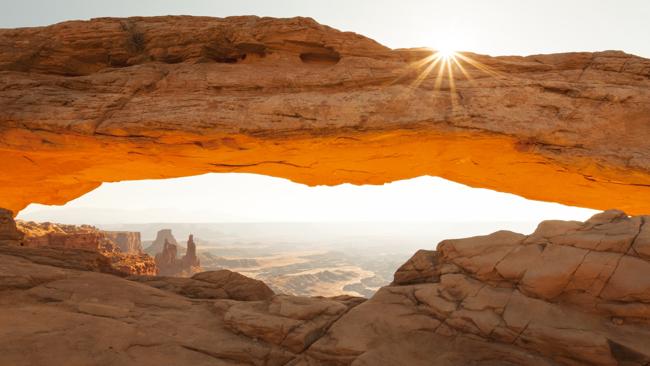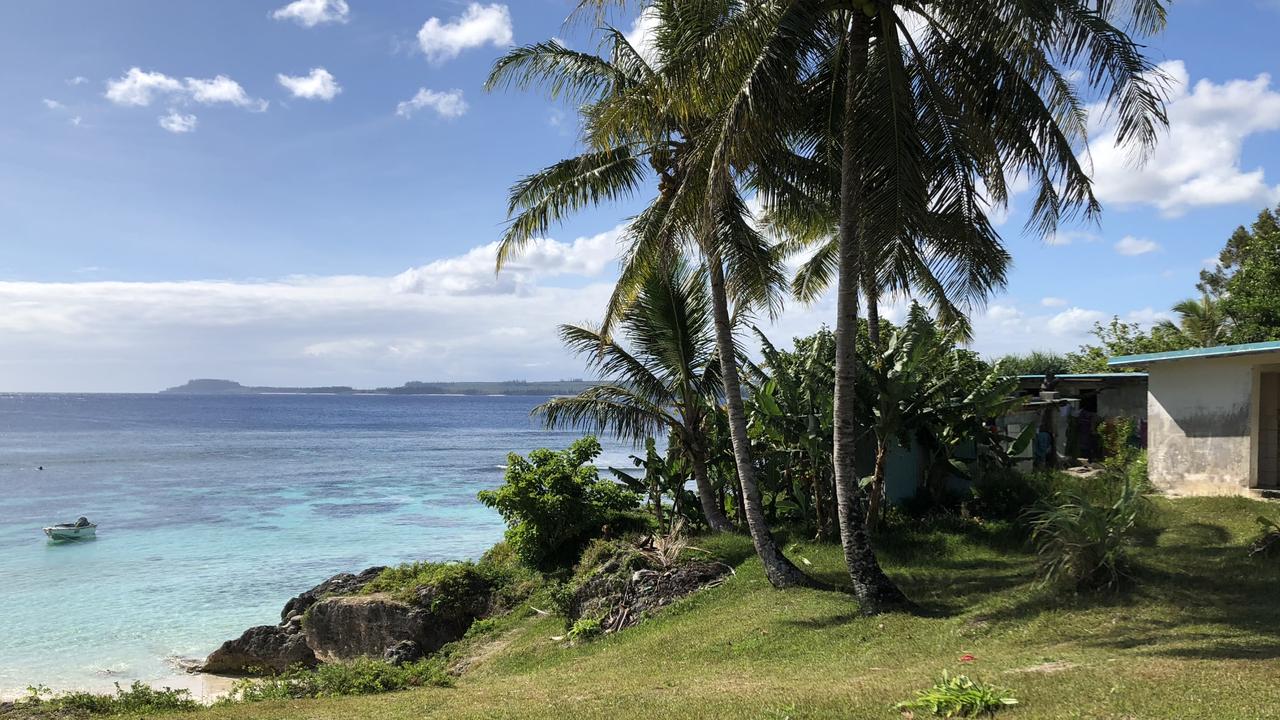Things to do in Utah, United States
UTAH'S national parks and state parks harbour some of the most extraordinary landforms on Earth and embody the spirit of the American frontier.

ANTELOPE ISLAND STATE PARK
In the southwest of the US lies the Great Basin - a region twice the size of Britain where the little rain that falls never makes it to the ocean. While streams in eastern Utah find their way to the Colorado River and eventually out into the Pacific, water in most of the western half of the state has nowhere to go but to sink into the desert soil or wait to vanish in the sun. Much of the water in the Great Basin collects and evaporates in the Great Salt Lake, leaving it up to eight times saltier than seawater. Roughly 11 islands are scattered around this shallow, briny expanse, although the exact number changes with the fluctuating water levels. The largest however, is always Antelope Island and, at 24km long, it provides a spacious sanctuary for one of the biggest herds of American bison. These symbols of the western frontier, also called buffalo, once roamed the plains of North America in their millions, but with the westward expansion of European settlers, their population was hunted down to a few hundred by 1890. The 600-odd bison on the island today are managed with more care, most visibly when they are rounded up in late October to be checked over and for a partial cull. American bison graze on the fickle shores of Great Salt Lake. Picture: Lonely Planet/Phillip Lee Harvey. The island, now a state park, was named in the mid-1840s, at a time when Mormon pioneers hoped to found their own state in what was then a remote part of Mexican California. Utah was ultimately annexed by the US in 1848. Getting there From Salt Lake City, it's about an hour by car north on I-15 to exit 332, then west across the causeway to Antelope Island (stateparks.utah.gov). There are campgrounds on the island. ARCHES NATIONAL PARK About 320km southeast of Great Salt Lake is a landscape that might lead the more suspicious visitor to think that someone has played a giant practical joke. Few natural phenomena look quite as unlikely as a natural arch or rock bridge, and this small corner of Utah contains more than 2000 of them. Arches National Park has one of the less imaginative names among America's 59 national parks. There is a solid scientific explanation behind these feats of stone. Parallel fissures in a pavement of rock widen over time to create a series of thin walls. If the walls erode quicker in the middle than at the top, hollowing out from either side, two dimples can become one big hole. For every successfully formed arch there must have been countless more collapses, and yet the geology of this layer of sandstone has ensured a greater and more varied concentration of natural arches than anywhere else in the world. Delicate Arch in Arches National Park. Picture: Lonely Planet/Phillip Lee Harvey. All the same, there are arches at Arches that strain credibility. The most extreme of all is Landscape Arch - 88m long but less than 2m thick at one point. Elsewhere are double arches, an arch like a whale's eye, a rocky outcrop with the profile of a sheep and a trio of stone turrets topped with giant boulders, nicknamed the Three Gossips. The symbol of the park, however, as seen on Utah licence plates, is Delicate Arch. Standing in serene isolation, not bridging any chasm or linking any outcrops, this is a truly decorative arch. Getting there From Salt Lake City, it's a four-hour drive south along I-15, Highway 6 and Highway 191 to the town of Moab, which is 10 minutes from the park entrance. Apart from camping in the park, Moab offers the closest accommodation to the main entrance. Rooms get booked up quickly. DEAD HORSE POINT STATE PARK The water that has worked its mischief at Arches National Park trickles into the Colorado River, which flows along the park's southern boundary. About 50km downstream, the current curves round in an attenuated bend, making a "gooseneck" on its southern bank. The effect is only fully apparent from the air, but Dead Horse Point is the next best thing - a viewpoint that looks down on the Colorado River from twice the height of the Eiffel Tower. On the far side of the river, the gooseneck juts out. Beyond this obstinate spine of rock that the Colorado has not yet managed to grind down, the river enters Canyonlands National Park. In another 500km or so, it will reach the Grand Canyon in Arizona, carving out gorges that are even deeper, but not quite as wayward as here. The exposed cliffs and slopes, devoid of plant life, clearly show the layers of rock and soil that have made this region such a geological playground. What is special about the Colorado Plateau is that it stayed remarkably stable while rocks all around it were being buckled during a continental uplift some 60 million years ago. The result has been the table-topped mesas that are some of the most distinctive features of the American Southwest. Dead Horse Point is the last stage before becoming a mesa - a peninsula of rock, like the gooseneck below it, but left high and dry. Getting there Moab is also the best base for visiting Dead Horse Point State Park and the northern part of Canyonlands. Dead Horse Point is a 40-minute drive from Moab northwest on Highway 191, then south on State Route 313. There's a limited campground near the visitor centre. CANYONLANDS NATIONAL PARK The largest of Utah's national parks is also its least visited. At its centre, the Green River flows into the Colorado River, dividing the park in a Y-shape with tortuous canyons unspanned by any bridge. Together with the detached enclave of Horseshoe Canyon off to the west, this means that Canyonlands often feels like four separate national parks. The northern and most easily accessible part of the park, between the two rivers, is called the Island in the Sky - a mesa about 20km long, branching off in dozens of spindly fingers. At one fingertip is Upheaval Dome, where jagged rocks at the centre of a circular void may be evidence of a meteorite strike 60 million years ago. On one of the eastern clifftops, Mesa Arch frames a view over valleys and sculpted rocks leading down to the recesses of the Colorado River. The Grand View Point overlook at the end of the Island in the Sky is only about 15km as the eagle flies from the Needles in the southern section of the park, but 200km and three hours by car. Instead of imposing mesas, the scenery here is more troglodytic, with crowds of hoodoos - columns of worn-down rock capped with more sturdy boulders that protect them. Both here and at Horseshoe Canyon are found the remains of cultures that existed here before the Spanish and "Anglo" settlers, from a stone granary built by Puebloan peoples to ochre-coloured rock art depicting ancient humans and the animals they hunted. The life-size figures in the Great Gallery at Horseshoe Canyon may be up to 4000 years old. Getting there The Island in the Sky section of Canyonlands is about an hour's drive from Moab along most of the same route as to get to Dead Horse Point. The Needles are a 1.5-hour drive from Moab. The western Maze section is not recommended except to very experienced 4x4 drivers, while Horseshoe Canyon can be visited with rangers on weekend hikes in spring and autumn. BRYCE CANYON NATIONAL PARK In the tales of the Paiute people of Utah, long ago there lived the To-when-an-ung-wa, or Legend People, who were animals of all kinds with the power to take on human form. They were arrogant and misused the land, so in punishment, the coyote god, known as a trickster by Native Americans, turned them all to stone. They still stand in their thousands at Bryce Canyon National Park, as the totem-pole-like rock formations known as hoodoos. Though Bryce Canyon is one of America's smallest national parks at just 32km long, the concentration of sunset-coloured hoodoos creates a mesmerising effect, as often happens when a shape is repeated everywhere the eye turns to. The park is not so much a canyon as the eastern edge of a great plateau, nibbled into a series of amphitheatres at a rate of about 1m every 100 years, through layers of limestone, siltstone and mudstone that give the hoodoos their segmented appearance. Getting there Park gateway Bryce Canyon City (population 138) is a four-hour drive from Moab on Highway 191, I-70 and Highway 89. Camping sites are available. For hotel accommodation in the park, try Bryce Canyon City and the nearby small town of Tropic (see brycecanyoncountry.com). ZION NATIONAL PARK Even with eyes closed, Zion National Park overawes with the names of its mountains and valleys - the Court of the Patriarchs, Tabernacle Dome, the Organ, the Pulpit and the Great White Throne. Mt Moroni bears the name of the angel who Mormons believe appeared to the founder of their church in the 1820s, and even the area's native religions get a look-in, with the Temple of Sinawava - that trickster coyote god again. One test of faith that many visitors are willing to submit themselves to is the trail to the top of Angels Landing. A rocky spine less than 2m across in some parts, with a 400m drop on either side, it climbs up to the summit of a tower of red rock. Angels Landing stands at the centre of the deep and forested Zion Canyon, embraced by a sweeping curve of the Virgin River and, in the absence of angelic onward transport, the only way back is the same knife-edge path. Zion is the midway point on a descent through geological time known as the Grand Staircase. Bryce Canyon, 64km to the northeast, is the top step - its rocks are less than 60 million years young. The Grand Canyon, 96km to the south and into Arizona, cuts into the Vishnu Schist at its base, laid down two billion years ago. Many corners of Zion are out of human reach, though bighorn sheep and mountain lions might tread there. Highly endangered California condors are sometimes seen soaring above the peaks. Getting there It's a 1.5 hour drive, mostly south on Highway 89, from Bryce Canyon City to the east entrance of Zion National Park. The attractive town of Springdale, at the southern entrance, is a further 30 minutes by car through the park. This route is open to drivers, but the park's main Scenic Drive is generally closed to traffic from April to October, with a free shuttle bus instead. There are three campgrounds in the park (one free). From the July 2013 edition of Lonely Planet's Traveller magazine. © MAKE IT HAPPEN - UTAH The great American road trip was surely designed with Utah in mind - bring those half-forgotten school geography lessons to life in surroundings shaped by the greatest forces on Earth ESSENTIALS Getting around Car hire rates at Salt Lake City airport start at around $40 per day (all figures in US dollars). Many companies charge hefty fees to drop off a rental car at a different location. Further reading Lonely Planet's Southwest USA covers Utah and neighbouring states, while Zion &Bryce Canyon National Parks is a detailed guide to all five national parks in Utah. See visitutah.com and goutah.co.uk for more. Nine steps to your trip 1. The Holiday Inn Express Layton is half an hour from Antelope Island (from $130), but there is more variety in Salt Lake City, at double the driving time. Try the Inn on the Hill - a b&b in a beautiful 1906 mansion on a hill above Temple Square (from $160). 2. Salt Lake City mixes Mormon heritage with a growing indie vibe and the healthy, outdoors feel of a city on the fringes of the Rockies. The renowned Mormon Tabernacle Choir holds free public rehearsals as well as ticketed events (public rehearsals Thu). 3. Half an hour's drive east of Arches National Park is Sorrel River Ranch - a 1903 homestead in a bend of the Colorado River. If you can stretch to a stay here, it offers luxurious log cabin rooms, a riverside spa and New American cuisine served on the wraparound veranda (from $550). 4. The nearest islet of civilisation to Arches, Moab has turned itself into Utah's recreation centre, with dozens of rafting and riding outfitters based here, and plenty of places to eat. For accommodation in town, try Cali Cochitta, a charming brick cottage b&b (from $160). 5. Moab is also the best base for Dead Horse Point and Canyonlands National Park, although for the southern (Needles) section of Canyonlands, Monticello is about 25 minutes closer by road. The Inn at the Canyons has modernised motel rooms (from $90). 6. It's possible to break the Canyonlands-Bryce Canyon drive (with a detour) at Capitol Reef National Park, named after a 100-mile-long buckle in the Earth's crust (3 per vehicle). As well as the nine-mile Scenic Drive, there are petroglyphs and homestead remains. 7. There is one hotel at the centre of Bryce Canyon - the rustic Lodge at Bryce Canyon, which is also the best place to eat in the area (from $200). Another good option is the Best Western Bryce Canyon Grand, just north of the park (from $160). 8. The log-cabin-style Zion Lodge is the only hotel inside Zion National Park (from $200). Just south of the park in Springdale are the quaint Under the Eaves Inn (from $120) and the Cliffrose Lodge with its welcoming riverside garden (from 115). 9. Zion is roughly 2 hours by car from Las Vegas, as opposed to 4 from Salt Lake City. If you find a deal that allows a one-way trip without a huge drop-off fee, it's quicker to head on to the bright lights of Vegas than loop back to Salt Lake City. Native Americans in Utah Utah takes its name from the Ute people, who at the time of first European contact lived across most of the state - the present-day Uintah and Ouray Reservation in the northeast is the second-largest reservation in the US. The linguistically related Southern Paiute people, who are renowned for their basketmaking skills, live in the southwest of Utah - part of a scattered language family that includes the tongue of the ancient Aztecs of Mexico. Together with the Navajo and Apache to the south of them, the Utes and Southern Paiute moved to the Colorado Plateau in around the 12th century, displacing the Ancestral Puebloan peoples, some of whose descendants now live in centuries-old adobe villages in New Mexico. These diverse tribes, and nameless earlier peoples before them, have all produced rock art at various times, which can be seen today in sites such as Capitol Reef National Park. These petroglyphs (inscribed into stone) and pictographs (painted figures) are usually mysterious, and some may have been the work of shamans or elders communicating with the gods. Others told stories of hunts and battles, served as agricultural calendars, marked tribal territory or were simple doodles in the rock. THE KNOW-HOW Safe walking in Utah's parks Most park visitors stick to shorter and well-travelled trails to the main sights, where park authorities will flag up any unusual dangers. Otherwise, the most important advice is to dress and prepare suitably for the climate. Sun, heat and (normally) lack of water are obvious factors, and sometimes altitude too, as at Bryce Canyon. Always carry spare water in your car, and make extra preparations for any walks. 'Prehydrate' by drinking lots of water the day and evening before a big hike, and aim to consume at least 4 litres of water over an active day in hot conditions. It's essential to maintain salt intake when drinking large amounts of water, so carry high-energy bars, trail mix or something else to munch. You are very unlikely to cross a mountain lion, but if you do, keep eye contact, wave your arms to look larger, and back away slowly without running. Rattlesnakes like to sun themselves in the afternoon, but will rarely bite unless harassed. Other venomous creatures generally prefer dark crevices. Although not as big a nuisance as in wetter parts of the US, poison ivy is still worth looking out for on trails. In Utah it appears as a low shrub, with broad, almond-shaped leaves that mostly grow in clusters of three. Hiking in the back-country away from the gentler trails requires many more precautions - if you're planning some serious walking, read up on advice in more detailed guides such as Lonely Planet's Zion &Bryce Canyon National Parks. Finally, remember that flash floods can rapidly fill up dry riverbeds and narrow canyons. Even if it's sunny where you are, a sudden rainstorm miles away can trigger a surge of debris-filled water - check the weather report for the entire region before setting out on a hike. (Lonely Planet Traveller Magazine)



